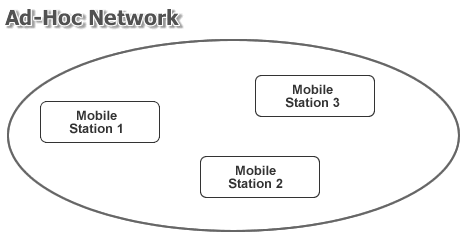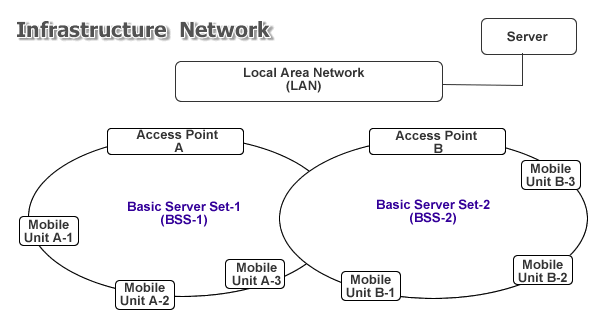802.11a - WiFi 2
- Year - 1999
- Frequency - 5GHz
- Speed - 54 Mbps.
The advantage of 802.11a over 802.11b is that there is also much less interference with radio at its 5GHz frequency in comparison to 802.11b and 802.11g.
802.11a does increase its transmission power to 50mW, but even so, 802.11a does not handle either longer transmit distances or obtruding objects (walls, furniture, etc.)
as well as 802.11b.
802.11b - WiFi 1
- Year - 1999
- Frequency - 2.4GHz
- Speed - 11 Mbps.
802.11b uses Direct-Sequence Spread Spectrum (DSSS) - a modulation method used to reduce signal interference - in the 2.4 GHz band, allowing speeds up to 11 Mbps.
The 2.4GHz band does a good job at penetrating obstacles to provide more WiFi coverage. Unfortunately with network interferences caused by devices operating on the same
frequency, such as Bluetooth devices, baby monitors, cordless phones, microwave ovens, speed is deminished.
802.11b and 802.11a are not compatible with each other. So, an 802.11b computer will not work with an 802.11a access point.
802.11c
An amendment to 802.11b, to help define the standard of development of access points (APs) for wireless technologies to bridge the information flow,
802.11c was established and its work has already been concluded.
802.11d
As the operation, especially in the 5GHz range, may differ from country to country (or domain to domain), the 802.11d protocol was established. It also better
defined interoperability issues.
802.11e
Developed to prioritize traffic and improve quality of service (QoS) for support of video and audio.
The process of creating a definitive standard can be slow, but the IEEE 802.11e standard will address existing QoS concerns
802.11f
This protocol specification addresses the roaming need for transmission for a user from one access point (AP) to another and ensures the continuity of transmission;
it would ultimately provide inter-access point protocol. Until this becomes commonplace, the safest bet will be to standardize on the same vendor for all of your access
points.
802.11g - WiFi 3
- Year - 2003
- Frequency - 2.4GHz
- Speed - 54 Mbps.
Created with merger of 802.11a and 802.11b standards in 2003. It supports a networking bandwidth up to 54 Mbps and operates under the
2.4 GHz band. Is backward compatible with 802.11b products.
802.11h
An extension of 802.11a to satisfy regulations in Europe for the spectrum band of 5GHz by providing dynamic channel selection (DCS) and transmit power control
(TPC). If it does, it may possibly supersede 802.11a.
802.11n - WiFi 4
- Year - 2009
- Frequency - 40MHz
- Speed - 600 Mbps.
Wireless-N improves speeds, reliability, and extends the range of wireless transmissions. It was the first standard to use Multiple-Input Multiple-Output (MIMO) technology.
MIMO products use a series of antennas to receive more data from one device at a time, which results in faster data transmissions.
The first to allow the usage of two radio frequencies – 2.4 GHz and 5 GHz. Backward compatible with 802.11a/b/g devices. With all its improved functionalities,
WiFi 4 supported speeds up to 600 Mbps and a claimed range of 70 meters indoors, which is a huge leap forward.
802.11ac - WiFi 5
- Year - 2013
- Frequency - - 160MHz
- Speed - 1300 Mbps.
The 5th generation of WiFi was established in 2013. To reduce interference in the 2.4 GHz band, it was developed to operate under the 5 GHz band.
Many 802.11ac WiFi devices are advertised as “dual-band” – technology that uses two frequency bands for wireless communication. To make that possible, some
vendors incorporated Wireless-N technology to make ac products compatible with the 2.4 GHz band. Data rates differ based on which frequency is being used, bandwidth
speeds up to 1300 Mbps can be achieved on the 5 GHz band, while the 2.4 GHz band has a max speed of 450 Mbps.
WiFi 5 was the first to use Downlink Multi-User MIMO. It took Wireless-N MIMO technology one step further to increase data transmission even more. DL MU-MIMO
allows wireless routers to transmit information to multiple devices at the same time, improving bandwidth speeds and reducing latency. With the help of Wireless-N
technology, 802.11ac is compatible with 802.11a/b/g/n.
802.11ad - WiGig
- Year - 2012
- Frequency - 60GHz
- Speed - 6.7 Gbps.
Designed to provide a Multiple Gigabit Wireless System (MGWS) with high throughput data, 802.11ad became part of the 802.11 series in 2012.
It achieved blazingly fast speeds - up to 6.7 Gbps. Unlike the previous standards, it didn’t use the 2.4 or 5 GHz bands, it operated under the 60 GHz band.
Remember, the higher the frequency, the shorter the range. Under perfect conditions, 802.11ad devices need to be about 30 ft from the access point.
802.11af - White Fi
- Year - 2014
- Frequency - 54 - 790MHz
- Speed - 35.6 Mbps.
Employs white space in the unused TV spectrum at frequencies between 54MHz and 790MHz, over very long ranges (possibly several miles). It can offer reasonable throughput,
perhaps 24Mb/s. Has similar applications as 802.11ah, also known as Low Power Wi-Fi, which will provide bandwidth for sensors and monitors in gadgets and appliances
that will join up to create the Internet Of Things.
The Internet of Things (IoT) is the interconnection of uniquely identifiable embedded computing devices within the existing Internet infrastructure. Typically,
IoT is expected to offer advanced connectivity of devices, systems, and services that goes beyond machine-to-machine communications and covers a variety of protocols,
domains, and applications. The interconnection of these embedded devices (including smart objects), is expected to usher in automation in nearly all fields, while also
enabling advanced applications like a Smart Grid.
802.11ah - WiFi HaLow
- Year - 2017
- Frequency - 900MHz
- Speed - 347 Mbps.
Aimed to use unlicensed frequency bands below 1 GHz. Its purpose was to establish lower energy consumption and create extended-range WLANs that surpassed
that of the 2.4/5 GHz bands. WiFi HaLow operated on the 900 MHz band, allowing it to have a theoretical range of 543m indoors (1,781.5 ft) and data transfer
speeds up to 347 Mbps.
Due to its low energy needs, 802.11ah is beneficial for devices trying to communicate over long ranges without using a lot of energy.
802.11ax - WiFi 6
- Year - 2019
- Frequency - 2.4 - 5GHz
- Speed - 10 Gbps.
Designed to deliver faster speeds, support more devices simultaneously, decrease latency, improve security, and increase bandwidth. To do so, it includes technologies
like OFDMA, MU-MIMO, 1024-QAM, and more. With all of its improvements, it has a theoretical maximum speed of 10 Gbps. Operating on the 2.4 and 5 GHz bands its backward
compatible with 802.11a/b/g/n/ac.
















































